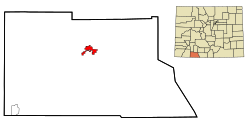Pagosa Springs, Colorado
| Pagosa Springs, Colorado | |
|---|---|
| Town | |

Tower at Pagosa Springs
|
|
 Location in Archuleta County and the state of Colorado |
|
| Coordinates: 37°16′5″N 107°1′28″W / 37.26806°N 107.02444°WCoordinates: 37°16′5″N 107°1′28″W / 37.26806°N 107.02444°W | |
| Country |
|
| State |
|
| County | Archuleta County Seat |
| Incorporated (town) | March 18, 1891 |
| Government | |
| • Type | Home Rule Municipality |
| • Mayor | Don Volger |
| Area | |
| • Total | 4.88 sq mi (12.64 km2) |
| • Land | 4.85 sq mi (12.57 km2) |
| • Water | 0.03 sq mi (0.07 km2) |
| Elevation | 7,126 ft (2,172 m) |
| Population (2010) | |
| • Total | 1,727 |
| • Density | 356/sq mi (137.3/km2) |
| Time zone | Mountain (MST) (UTC-7) |
| • Summer (DST) | MDT (UTC-6) |
| ZIP codes | 81147, 81157 (PO Box) |
| Area code(s) | 970 |
| FIPS code | 08-56860 |
| GNIS feature ID | 0184338 |
| Website | www |
Pagosa Springs is a municipality that is the county seat of, and the only incorporated municipality in, Archuleta County, Colorado, United States. The population was 1,727 at the 2010 census. Approximately 65 percent of the land in Archuleta County is either San Juan National Forest, Weminuche and South San Juan Wilderness areas, or Southern Ute Indian land.
Pagosa Springs and the surrounding county are both experiencing a substantial influx of second-home owners; a 2006 property assessment indicates that 60% of area private properties are owned by non-residents.
Pagosa Springs is located approximately 35 miles (56 km) north of the New Mexico border, nestled at 7,000 feet (2,100 m) on the Western Slope of the Continental Divide. This combination of high desert plateau and dramatic Rocky Mountains to the north and east creates an unusually mild climate, especially in the summer months, when compared with much of the surrounding Southwest. Pagosa is favored with around 300 days of sun each year, as well as four distinct seasons.
The town is located in the upper San Juan Basin, surrounded by the 3 million acre (12,000 km²) San Juan National Forest, and adjacent to the largest wilderness area in the state of Colorado, the Weminuche Wilderness.
The town is named for the sulfur springs located there, including the world's deepest geothermal hot spring. This "Mother Spring" feeds the pools hosted by three local hot spring soaking locations within town. The largest is at The Springs Resort & Spa which hosts the mother spring. Other hot springs facilities in town are the Healing Waters Resort and Spa and the Overlook Hot Springs Spa. The mineral-rich water continues to be celebrated for its therapeutic powers. The Utes called the sulfur-rich mineral springs Pah gosah, which is commonly translated in modern documents as "healing waters"; a Ute elder once translated the phrase as "water (pah) that has a bad smell (gosah)."
...
Wikipedia
